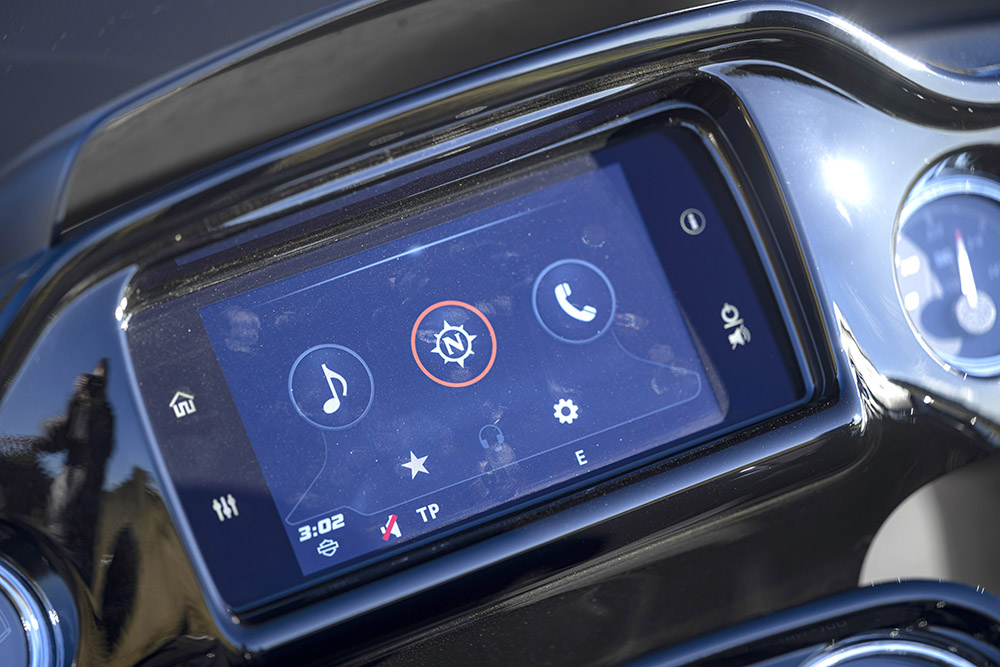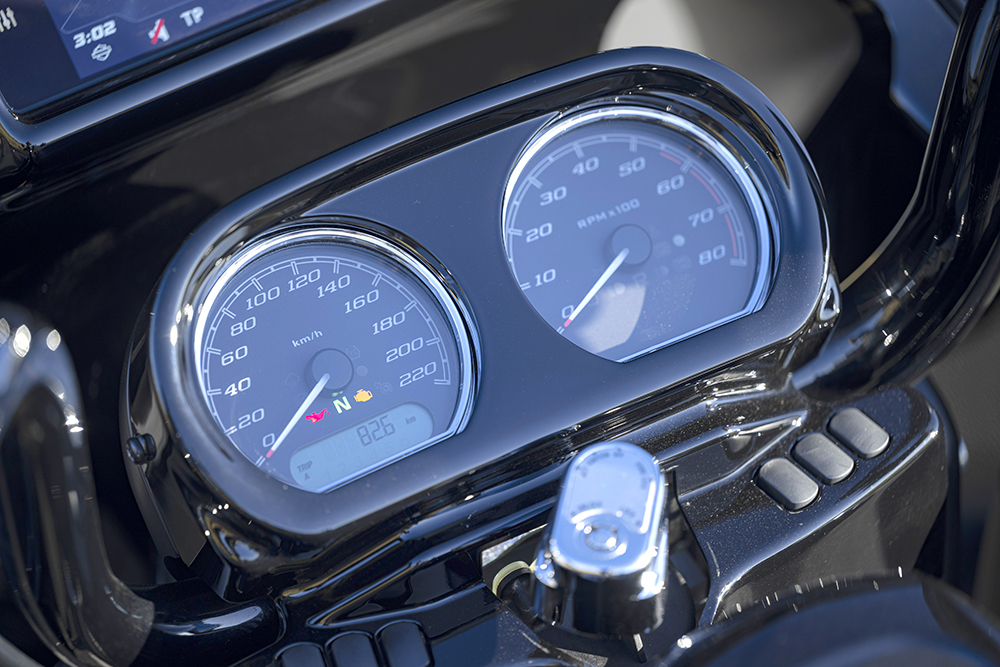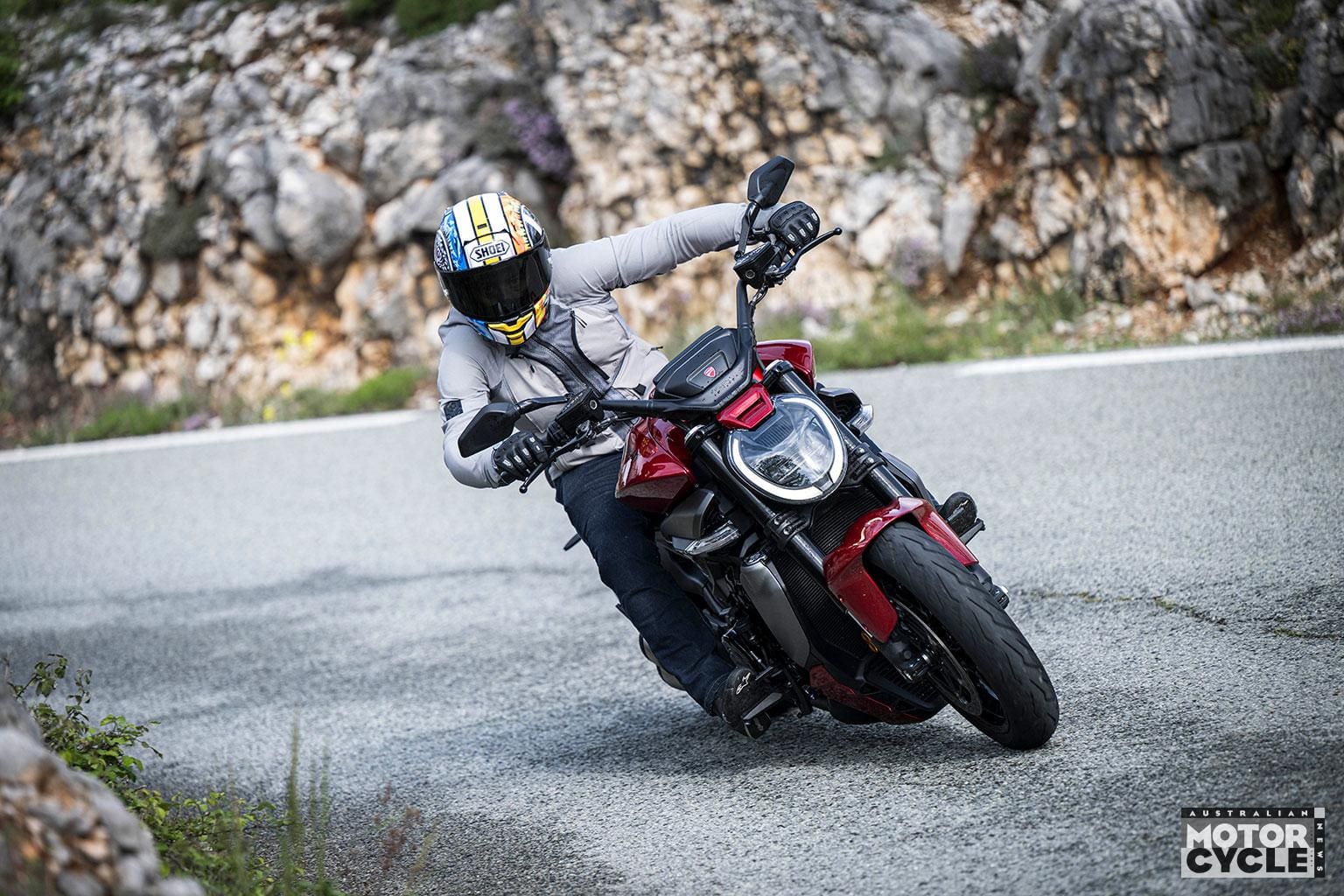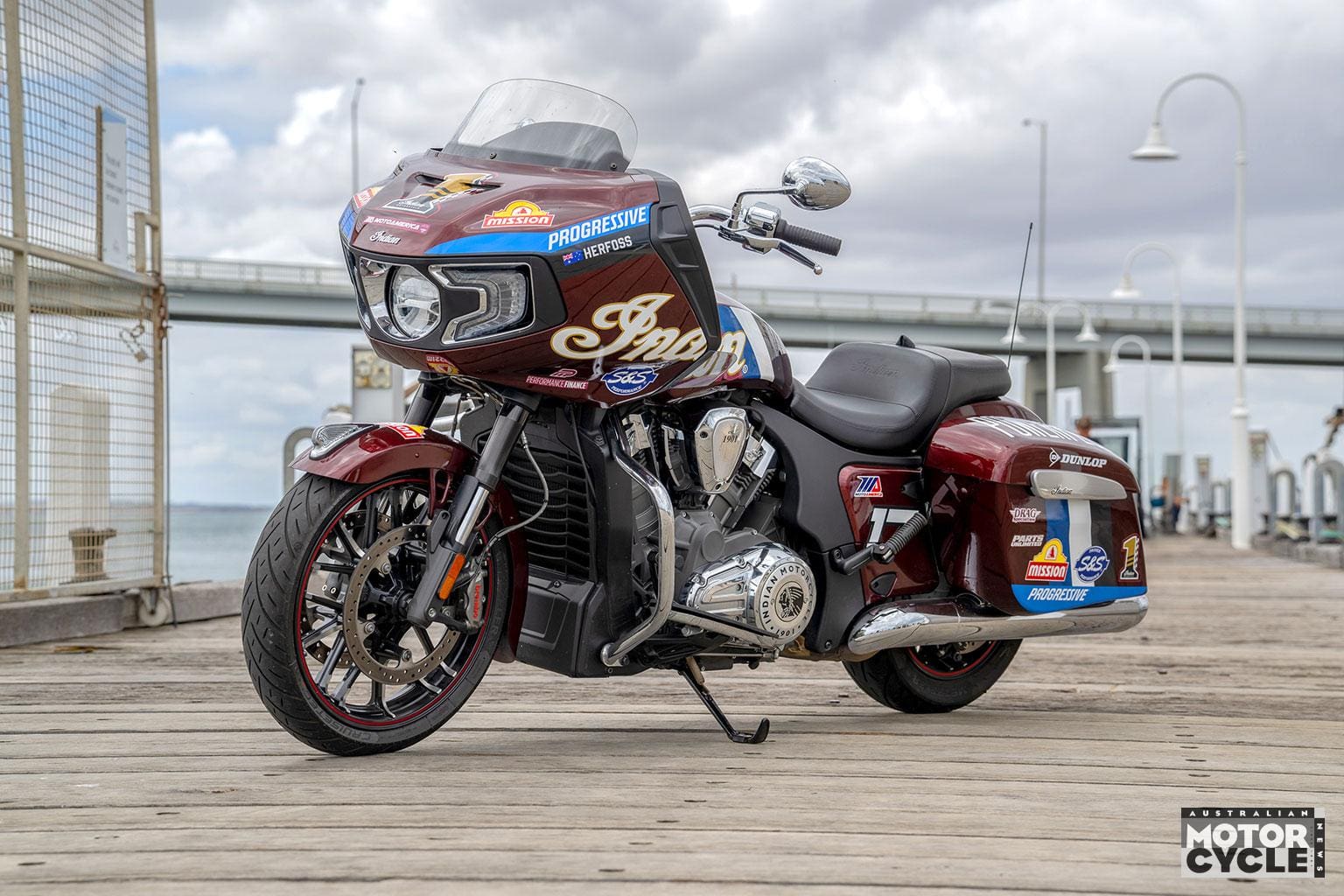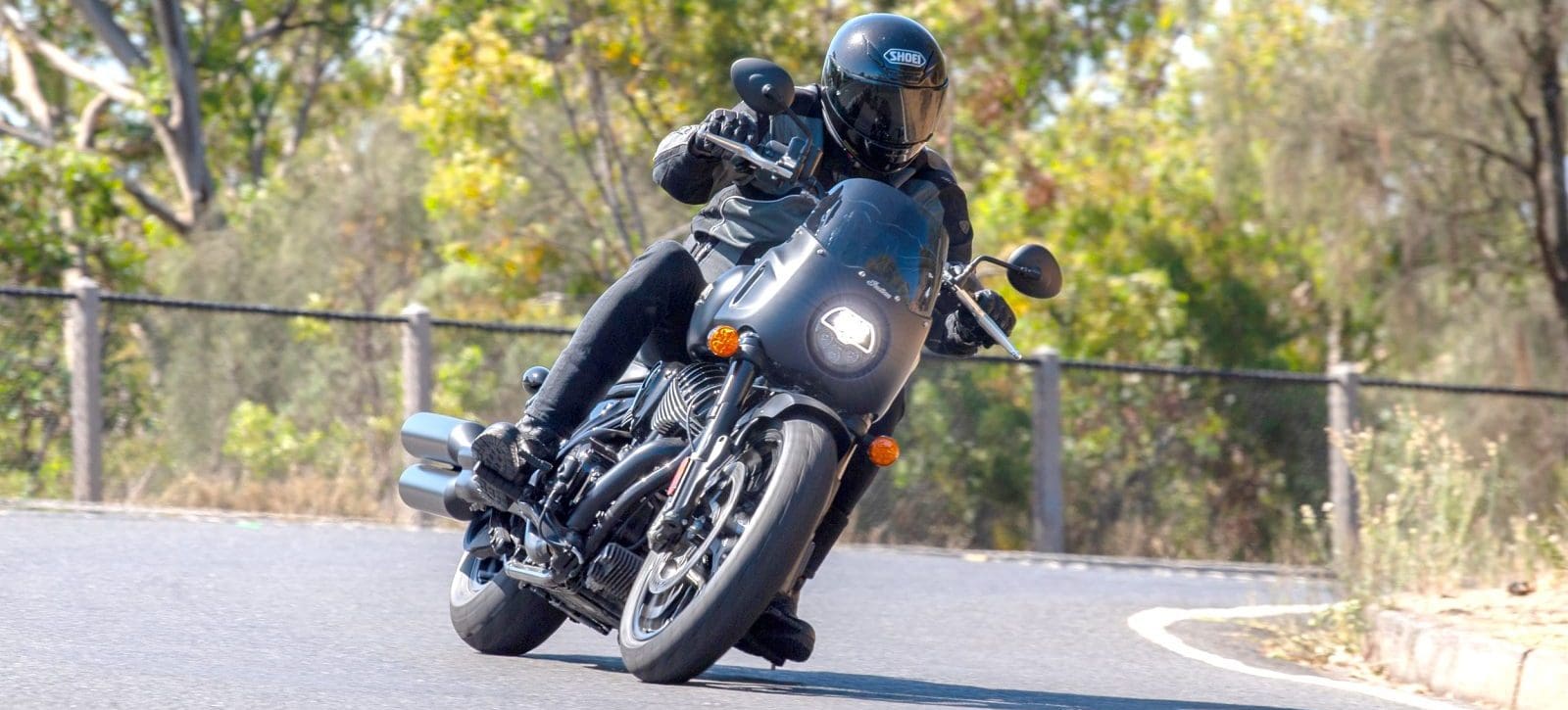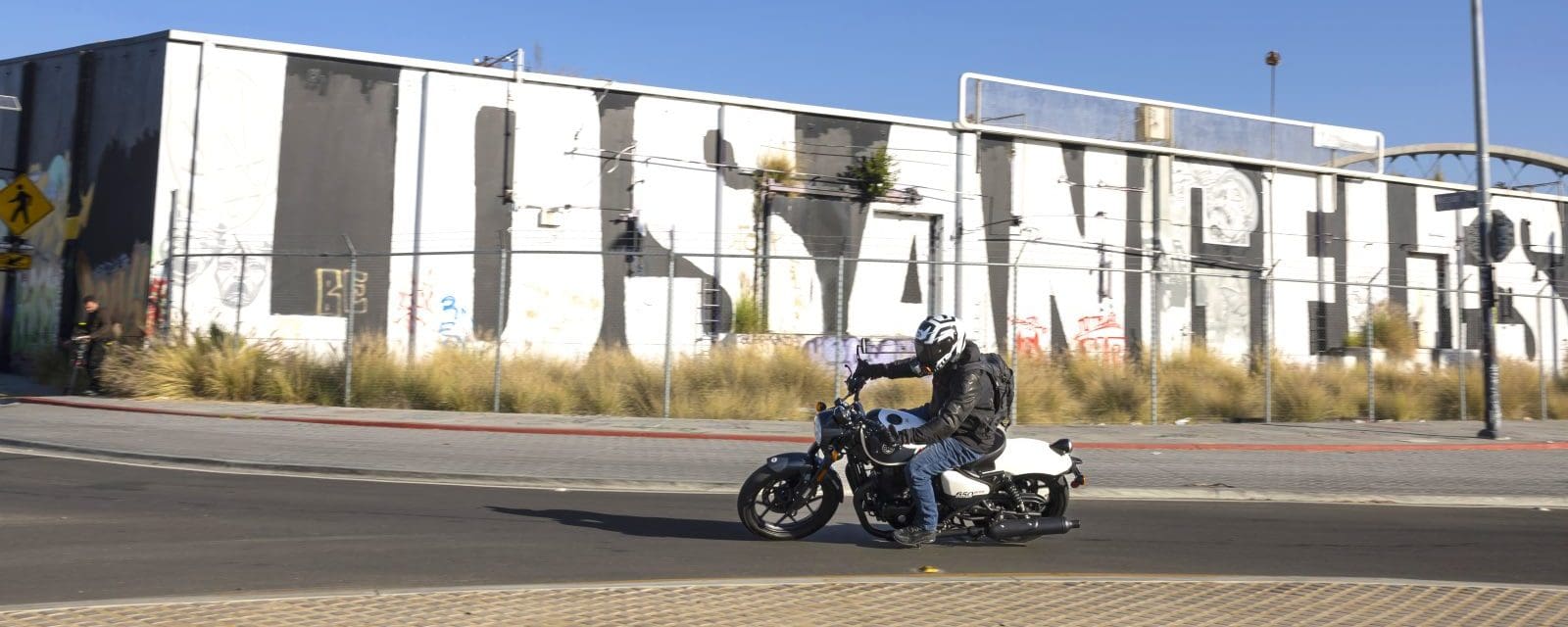The Road Glide Silhouette is iconic. The high mounted shark-nose fairing sitting proud, short screen, high bars and low seat nestled in behind the classic Harley teardrop fuel tank. Some things just aren’t meant to change. So only minor tweaks were needed to polish Harley’s 2022 Road Glide ST into a future icon.

The 2022 Road Glide ST is essentially the same bike as the Street Glide ST from the fuel tank back. Pete Vorst thrashed one a short time back (AMCN Vol 71 No 20), even taking it to the racetrack. In theory, the Road Glide should handle better than the Street Glide, well at least it should feel like it does, as the front fairing is not attached to the fork, rather it is attached to the frame to reduce effects from turbulent air and cross winds on the steering. I haven’t been able to compare the two back-to-back, but I punted the Road Glide in some terribly windy conditions and it was rock solid. The only downside is my arms aren’t long enough to reach the touch screen comfortably while on the move. Luckily you can operate most functions from the bar-mounted switchblocks.
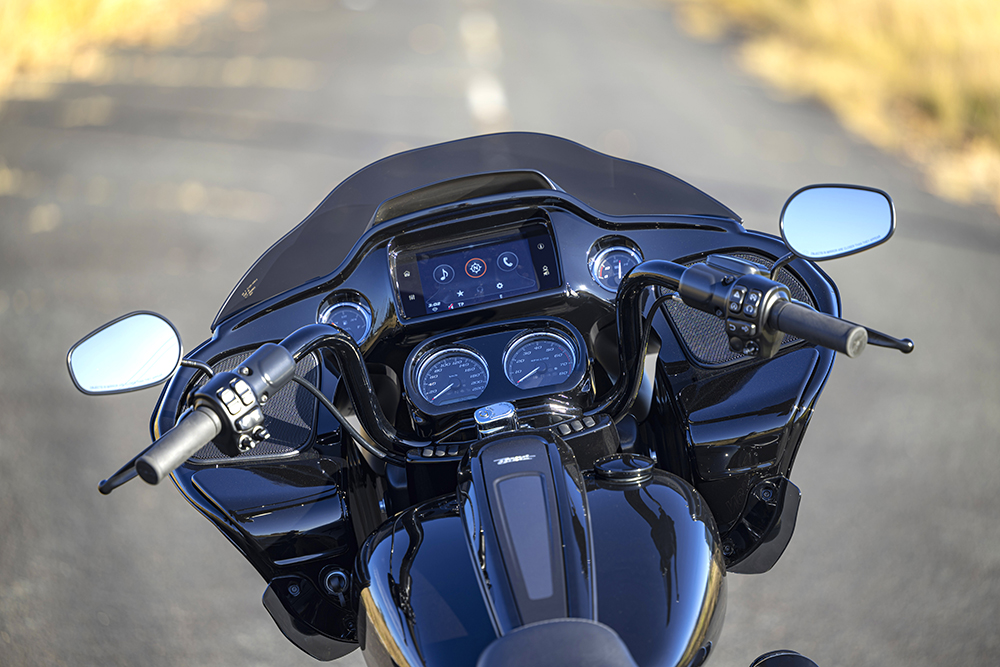
The ST model gets a few tweaks over the base Road Glide. A chopped down front guard for extra weight saving and a sportier looks shows off the bronze front wheel nicely. Also, the rear guard is chopped down to match and the bags are shallower so they don’t scrape on the ground when cutting sick. And the jacked-up rear shocks allow the ’Glide to achieve a fairly respectable lean angle. Throwing the Road Glide into corners is pretty effortless and the geometry makes changing direction an easy task for a big bike.
The Road Glide does prefer sweepers and constant-radius corners – as most heavier bikes do – but once cranked over it is stable and holds a line well. Negotiating switchback corners takes a bit of pre-planning, luckily the brakes and cornering ABS are up to the task, there is no hiding the length of the big Harley, but at low speed, the low centre of gravity makes full-lock and feet-up U-turns a breeze.
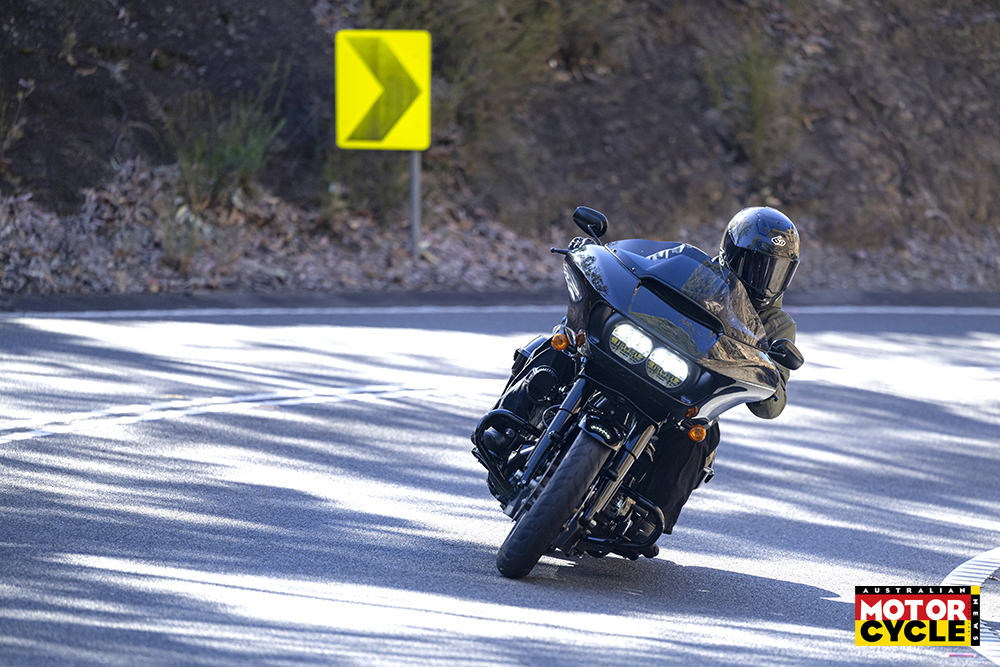
The thundering 117 cubic-inch Milwaukee-Eight V-Twin takes centrestage on the 2022 Road Glide ST, as it does on all of the ST models in the range. It’s a serious lump of a thing, in fact, the biggest factory installed engine to ever roll off Harley Davidson’s production line. Pumping out 79kW and 168Nm. That’s a 5kW and 10Nm increase over the regular 114 cubic-inch lump which is something, but we always want more don’t we? It’s a good match for the performance bagger and makes me feel like I’m competing in a King of the Baggers race through the back roads. The power piles on hard from low in the revs and builds right up through the mid range. It is still pulling strong when the rev limiter stops the fun kind of early at around 5000rpm, but there is a lot of weight flying around inside that engine at those revs.
There is no mistaking what engine is powering the beast as it says so on the side of the 90º heavy-breather intake which subsequently tries to inhale small animals every time you wind the throttle on. It certainly looks cool, but applying rear brake involves a strategic leg manoeuvre to reach around the intake and find the brake pedal properly. Not ideal.

The engine is a bit of a spectacle to look at, too. The black and bronze colour scheme starts with the cylinder heads, blacked-out engine cases, horn, intake and polished cooling fins. The whole engine looks super trick and I dare say easier to keep looking clean than a mostly chrome engine.
The matching blacked-out twin exhausts look great and don’t scrape on the ground. They make enough noise to let you know how much fun you’re having, but they’re probably not noisy enough to satisfy a die-hard Harley fan.
With bucket loads of torque available right off idle, the 117 cubic-inch twin propels the Road Glide off the line pretty swiftly with little effort on the clutch hand. If you somehow find yourself in a situation where you have turned the traction control off, hold on tight as things get wild in a hurry when you drop the clutch. No wheelies here, though, just wheelspin. The cornering traction control does have a bit of a job to do as the torque can spin the rear tyre at a moment’s notice or even less. There’s no switchable ride modes as such, but the traction control system does have a switchable rain mode to harness all of that grunt in greasy conditions. The little TC light is quick at pointing out the flaws in my throttle application and that’s not even in rain mode. Reaching full throttle takes considerable effort as the throttle feels like it just keeps on turning. A short-action throttle would be nice addition but could make small throttle inputs a bit jerky.
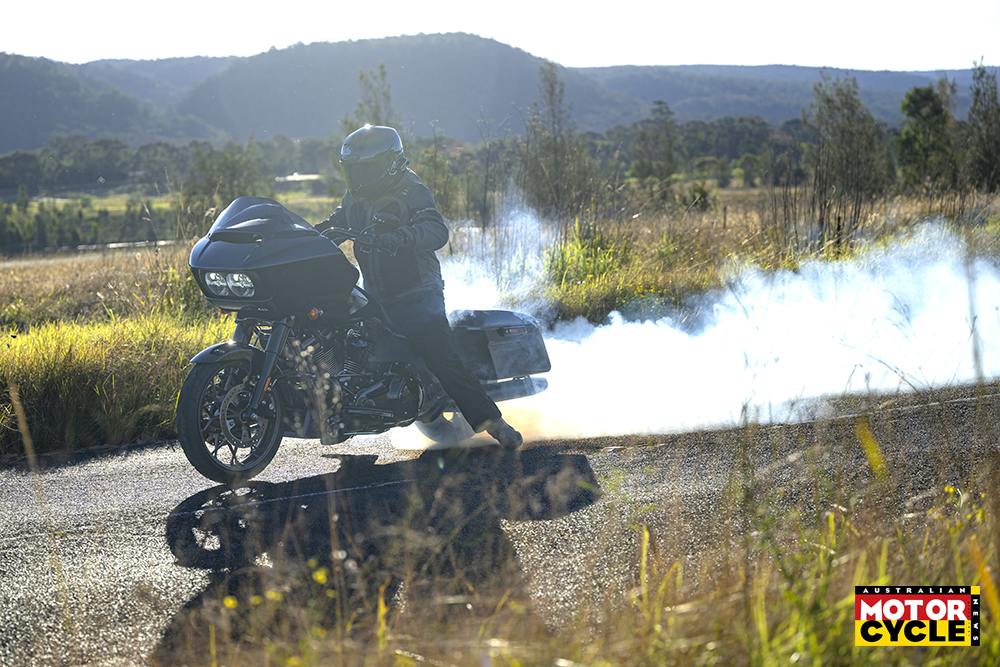
The six-speed gearbox has pretty wide ratios, clicking sixth gear doesn’t feel necessary until well over 100km/h which keeps the revs at a gentle purr when cruising on the highway. The gear change feels solid, a decent clunk can be felt as I engage first gear, but changing between the gears feels positive without being rough.
Finding neutral is a pain in the butt for me, my experience was completely different to Pete’s on the Street Glide. Maybe my clutch just isn’t adjusted into the sweet spot. The levers are non-adjustable, so I can’t even blame that for upsetting things.

Even with that jacked-up rear suspension, the seat is pretty low at 710mm. I can plant two feet flat on the floor with ease which reduces stress levels when pulling up on uneven surfaces. And it could be a stressful task otherwise, because the Road Glide weighs 382kg. But with the low centre of gravity, it doesn’t really feel that heavy once it’s rolling. This is partly thanks to the Harley’s steering geometry where the fork actually sits behind the head stem. This creates a feeling that the bike kind of wants to balance on its own at low speeds – quite nifty, if you ask me. Its weight does become apparent when it’s time to lift it off the side stand however.
The seat is comfortable enough for full day rides. The shape of the seat makes you sit in it rather than on it which doesn’t allow much room fore and aft, but it does keep me from sliding off the back when things get rowdy. Fortunately (or unfortunately), you won’t have to worry about losing your pillion off the back when getting rowdy as they aren’t catered for whatsoever on the ST in standard spec. If you want to share the 2022 Road Glide ST with your favourite passenger, a quick stop by the accessories catalogue is required to pick up some passenger footrests and a pillion seat. I think doing so would ruin the bagger’s lines a bit.
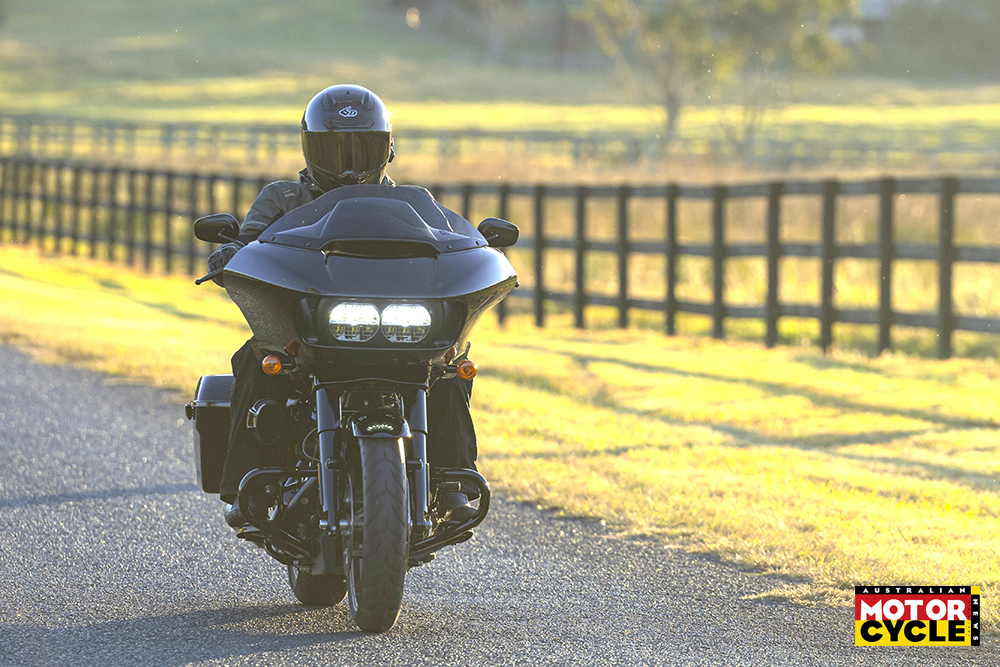
The stock riding position pretty good. The handlebar is high and fairly close, so reaching full lock is not too much of a stretch. The rubber-mounted running boards are positioned slightly forward without being a stretch. They are the first point of contact with the road while cornering aggressively, but this is better than grinding the hell out of the nice black mufflers.
The Glide’s infotainment system is absolutely superb. Why more bikes don’t come with Apple Carplay/Android Auto systems, I don’t know, it’s is so simple to use and fuss free. If you don’t want to connect via Carplay, you can just hook up via Bluetooth and use the Harley’s in-built maps and media player which work perfectly well. My phone slipped beautifully into the storage compartment in the fairing with the USB socket inside and I was good to go. You can’t actually take calls on the standard infotainment system, there is no microphone, so I would look at adding the optional Bluetooth module to allow a headset to be used through the system. The two fairing-mounted speakers do a reasonable job if you wear an open-face helmet, but I wear a full-face, and need full volume to hear music at anything over 80km/h. Of course then when I slow down, everyone judges my taste in music.
The 22.7L fuel capacity isn’t huge for a tourer, but I managed 447km out of the tank with a fuel consumption 4.9L/100km without trying to make good economy. Range anxiety is certainly not an issue here.
The 2022 Road Glide ST makes a bloody good tourer right out of the box. There is little money needed to be spent over and above the $45,995 asking price – but nor should there be at that price. A few essentials for me would be the Bluetooth module, some free-flowing pipes and a pillion set-up to keep the tin lids happy. It’s certainly not the cheapest way to go touring, but if the American way floats your boat you will not be disappointed.

SHARK NOSE
The fairing sits high and mounts to the frame rather than the ’bar. It’s a bit more high tech than it appears as it keeps air flowing but eliminates buffeting and turbulence in your face.
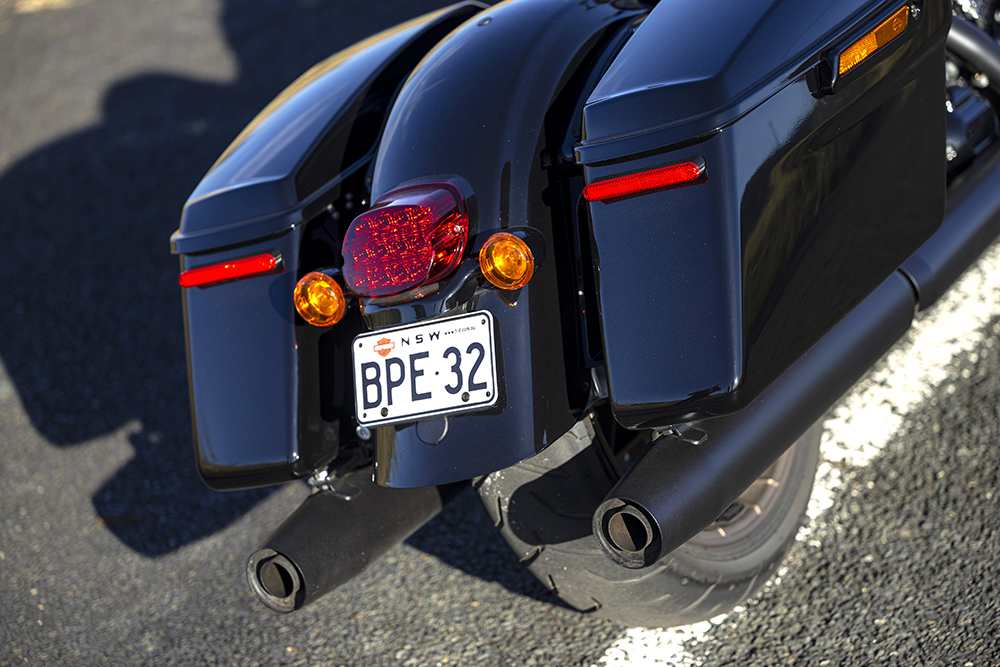
NO FREE RIDES
The ST is a single-seat affair. It keeps the bike looking sleek and King of the Baggers race ready, but there will come a time when you will want to share the fun with a pillion.

DEEP BREATHS
117 cubes of freedom certainly swallows some air at 5000rpm. Harley has fitted the cool looking Heavy Breather intake, but it sometimes makes getting to the rear brake quickly an effort.

BAG IT UP
The ST has shorter bags than the CVO and the Special to increase cornering clearance. Capacity is reduced, but not as much as it would be if you wore a hole in the bottom.

GOT ANY BLACKER?
The blacked-out forks, crank cases, horn, intake and mufflers look the bomb and are way easier to keep clean than chrome. If it’s too much black, check out the Gunship Gray colour.
![]()
Race Glide
The Road Glide money can’t buy
In 2020, MotoAmerica launched the “King of the Baggers” race series, giving bagger-style cruisers an opportunity to compete on road-racing circuits. Harley engineers set about building a Road Glide racebike with no expense spared. This bike was the inspiration for the ST range.
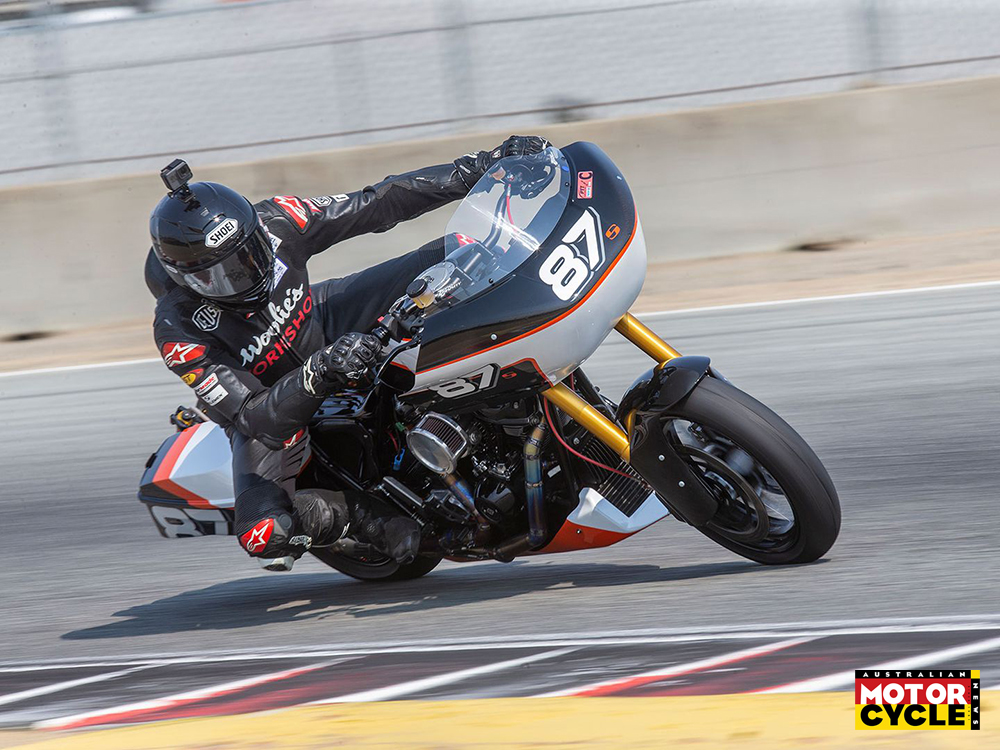
The Road Glide frame was paired with a 131 cubic-inch motor from the Screamin’ Eagle catalogue, which was subsequently torn down and given a significant overhaul internally and externally. The massive engine redlines at 7000rpm and churns out over 110kW and 160Nm, a substantial increase over the roadbike to say the least.
The front fairing, saddle bags, front and rear guards were all replicated in carbon fibre to save weight then, to pass scrutineering, a bellypan was created to catch any stray fluids should the engine suffer a failure on the racetrack.
Lightweight racing 17-inch wheels were used to make use of MotoAmerica Superbike-spec slick tyres, while major changes to the bike’s chassis included a billet aluminium swingarm made just for this project. A racebike wouldn’t be complete without a full Superbike-spec Öhlins fork and twin remote-reservoir Öhlins rear shocks, while race-spec Brembo brakes were fitted up to grab twin 300mm discs.
All the unnecessary parts were removed like infotainment, lights, seat and foot rests. A 3D printed seat was made up as well as new foot rests and handlebars to optimise the rider’s position on the bike. Finally, the Road Glide was converted to chain drive to allow for quick gearing changes.
After all these changes, the bike tips the scales at the class minimum race weight of 283kg. That’s 100kg less than the Road Glide ST. Professional Superbike racer and certified madman Kyle Wyman was chosen to pilot the beast in the first series and cranks it around racetracks with up to 55º lean angle!
Sadly, Harley won’t sell you one. But you could make your own…
TEST // DAVID WATT
PHOTOGRAPHY // INCITE IMAGES
![]()
Second opinion
You may think that Harley’s Road Glide ST and Street Glide ST look almost identical apart from the front fairing, and you’d be mostly correct. The word on the street is that the Road Glide is the preferred choice for the crazy folk who want to compete in bagger racing because the frame-mount fairing doesn’t weight the steering compared to the Street Glide’s fork-mounted fairing.
That may be the case if you’re racing, but after riding both back-to-back at the launch of the ST range in Bright I’d go with the Street Glide ST, but there’s nothing in it. I preferred the handling of the Street Glide on everyday roads you and I ride on. The fork-mounted fairing on the Street is ever so slightly a hinderance when you turn the ’bars when stopped, but when you’re rolling, the extra weight acts in a similar way to ’bar-end weights dampening the steering, giving a more stable and reassuring feel.
Both machines feature the same suspension, but I preferred the handling of the Street, and I rode them back-to-back through the same set of fast and bumpy corners. The Street Glide feels sportier and more composed if you’re playing, the rear suspension works better in general and puts less shock up your spine if you slam a pothole. At 369kg, the Street is 13kg lighter than the Road so this could account for the difference.
If you’re not the kind to go chasing corners on your bagger, then there’s really bugger all difference, and the extra bit of storage offered by the Road Glide fairing’s storage compartments might get it over the line. But for me, if I’m buying a performance bagger, handling trumps trinket storage – so it’s the Street Glide ST for me.
